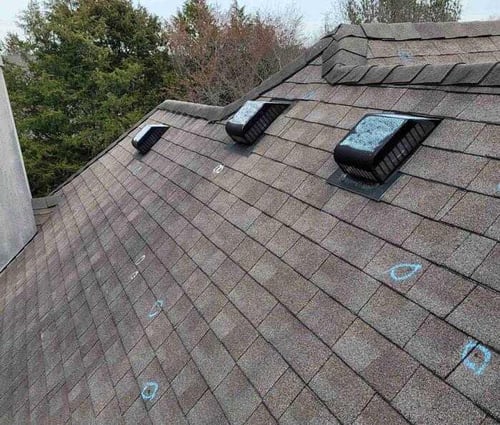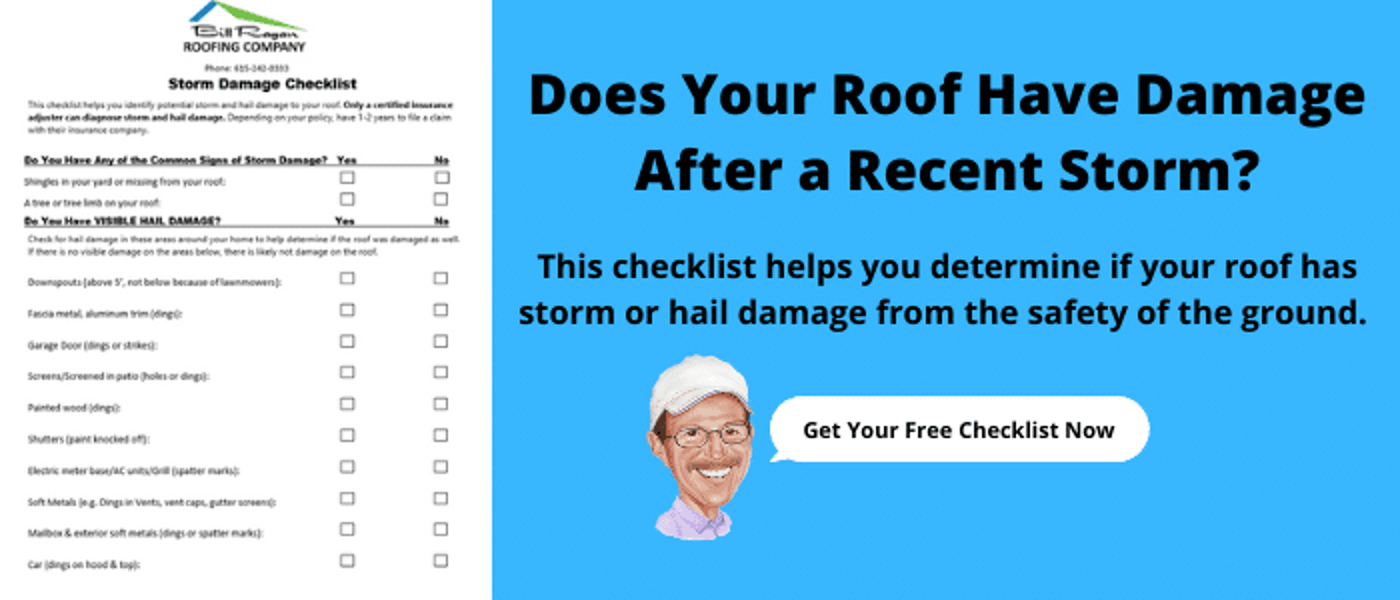7 Steps to Get Insurance to Pay for a Roof Replacement

Was your roof damaged after a recent storm? Are you wondering how to get insurance to pay for a roof replacement?
With the increase in severe weather in recent years, this is becoming a more and more commonly asked question. However, getting a new roof through insurance isn’t always the easiest thing to do.
For over 30 years, Bill Ragan Roofing has guided homeowners through the claim process and dealing with insurance to take care of their damaged roofs. Now, I’ll do the same for you.
Let’s look at the 7 steps you should take to get insurance to pay for a roof replacement.
1. Photo document noticeable roof damage from the ground
The very first thing you need to do is make sure you have a viable claim and photo document any noticeable roof damage. This won’t guarantee approval, but it helps determine if it’s worth starting the process.
Walk around your property looking for clear signs of wind damage, such as missing, creased, or sliding shingles. Hail damage is hard to spot with an untrained eye, so I recommend looking for collateral damage to your property to learn if your roof was possibly impacted.
Collateral hail damage will show up as:
- Dents in downspouts (Above 5 feet, so it can’t be blamed on a lawnmower)
- Dings or strikes to your garage door
- Holes in your window screens
- Dings to any painted wood or shutters
- Splatter marks or dings to your electric meter, AC unit, or grill
- Dents to your mailbox and other soft metals on your property
Unless you are 100% comfortable on a ladder, I recommend photo-documenting any roof damage from the safety of the ground. Your adjuster and roofer will perform an inspection, so there’s no reason to risk your safety.
2. Review your policy
After determining if filing a claim is worth it, reviewing your policy is crucial. You need to ensure you have coverage for hail, wind, or fallen tree roof damage caused by storms and any exclusions.
After ensuring that roof damage is covered, check if your policy is an Actual Cash Value or Replacement Cost Value. The one you have determines if the insurance company will pay for a full roof replacement.
Actual Cash Value policy
An Actual Cash Value (ACV) policy only provides a payout for what your roof is valued at the time of the claim, also called the depreciated value. This policy will never be enough to cover a quality roof replacement, which leaves you paying for the rest of it out-of-pocket.
There are roofers out there willing to do replacements for ACV payouts, but this guarantees using cheap materials and labor and/or hidden fees after the job is complete.
Replacement Cost Value policy
A Replacement Cost Value (RCV) policy is supposed to fully cover what it costs to replace your roof. You’ll get a first check for the actual cost value, while insurance holds back the rest in recoverable depreciation.
After your roof replacement, you’ll get a second check covering most or the rest of the cost if everything checks out. Just keep in mind the insurance company is only paying to restore your new roof to a brand-new version of itself.
This leaves you paying the difference out of pocket for any upgrades or changes, like going from 3-tab asphalt shingles to architectural asphalt shingles.
3. Start the claim process with your insurance company
After checking your policy and deciding to move forward, the next step is to start the claim process by contacting your insurance company. You’ll pass on all the relevant information, and they’ll walk you through their process and send out an adjuster or tell you to contact a roofer first.
No matter who comes out first, both the adjuster and roofer will perform their own inspections. However, it’s a good idea to have a trusted roofing contractor handy to guide you and help prove you have a viable claim if there’s actual roof damage.
And if they send out an adjuster first, having your trusted roofing contractor there for the inspection is a great way to keep them honest.
4. Get a storm damage inspection from a reputable roofing contractor and adjuster
After talking to your insurance company about the process, the next is simply a storm damage roof inspection. Even though this is step 4, it’s common for homeowners to get an inspection from a roofer before filing to feel 100% confident about moving forward.
The adjuster and your roofing contractor need to perform their inspections at some point anyway, so this is completely fine. Whoever inspects first will mark roof areas with missing shingles, granule loss, hail marks, dents in metal, and any other storm damage signs with chalk.
 (Hail damaged roof marked with chalk)
(Hail damaged roof marked with chalk)
After marking the roof damage, they’ll take pictures of everything to submit for review. While very rare, an adjuster may make a decision based on the roofer’s inspection if the damage is obvious.
Keep in mind that most adjusters aren’t professional roofers or have roofing experience. Mistakes happen or things are missed, which is why you should have your roofing contractor there for an adjuster inspection.
5. Supplement anything missing from the insurance estimate
For an RCV policy, the insurance company provides an estimate for the scope of work to replace it. Unfortunately, most insurance estimates leave off certain line items and important things businesses need to stay open, mainly overhead and profit.
If you want most or the full cost covered, you’ll need to put in the time and effort to supplement your claim. You’ll have to take the roofer’s estimate, review the difference in line items, make the appropriate changes, and submit it to your insurance company for approval.
A roofer can provide tools and help you with the process, but you’re the only one with the right to supplement as the policyholder. For example, I give homeowners a Supplementing Checklist to help them recognize the line items insurance should cover with an RCV policy.
Getting it approved without hassle is rare, so there’s usually some back-and-forth before coming to an agreement. However, whether or not to do this is completely up to you.
So, if you’re happy with the payout and don’t want to deal with supplementing, you’ll pay your deductible plus the difference in the estimates.
6. Replace your storm-damaged roof per the scope of work
Now, it’s time for your roof replacement. If you have an ACV policy, you’ll get a quote from your roofing contractor, use the actual cash value payout (minus your deductible), make up the price difference out-of-pocket, and get your roof replaced.
However, RCV policies work differently. You’ll first get the ACV check from the insurance company to cover your deposit, and the roofer will schedule your roof replacement.
They’ll look over the insurance paperwork so they follow the scope of work approved by your insurance company. They’ll replace your roof per the insurance claim while also going off their estimate to ensure you get a quality roof that’s up to local codes.
However, the process for an RCV policy isn’t done after your roof replacement is completed.
7. Get the final check to finish paying for your roof replacement
If you have an ACV policy, the insurance process is done once your roof is replaced. If you have an RCV policy, you still need to get the recoverable depreciation to pay for the rest of your roof replacement.
After your roof is replaced, your roofer will take photo documentation and submit it to the insurance company to prove it was done per the claim. Once they determine it matches the scope of work, you’ll get a second check (minus your deductible) with the recoverable depreciation to put towards what’s left to pay.
If you already paid your roofing contractor for the full amount out of pocket, you’ll keep the second check. If you didn’t, you must sign over the recoverable depreciation check to cover what’s still owed to your roofer.
How do you avoid falling for common roof damage insurance scams?
Now you know the 7 steps to follow to get insurance to replace your roof. The thing to keep in mind is that finding a trusted roofer is the most important part of this.
Unfortunately, insurance work brings out the worst in the roofing industry. Plenty of bad roofers are out there looking to make a quick buck, leaving you with a poorly installed roof.
Even scarier, there are scams that lead to insurance fraud that falls back on the homeowner. This is the last thing you want, trust me.
That’s why I wrote another article with tips to spot insurance scams from a mile away.
Check out 6 Tips to Avoid Roof Damage Insurance Scams to ensure you don’t fall victim to a bad roofer or inadvertently commit fraud.


